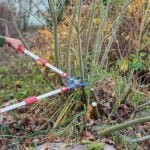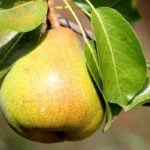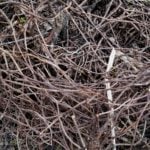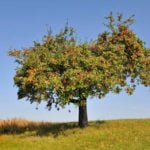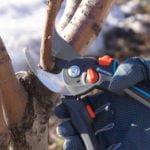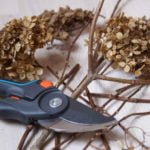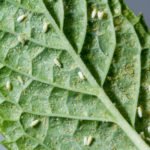Let’s see what kind of tool is needed for pruning.
For convenient operation, it is desirable to have a variety of cutting tools, since special ones always surpass universal ones.
Saving on the purchase of a high-quality cutting tool is unwise. What could be better than spending a more or less tidy sum in one day and enjoying the pleasure of work for many years, or throwing money away every year on a simple and clumsy tool that mocks plants, itself and others and makes you contemplate this sad picture?
What is needed for pruning?
1. Cutting tool:
- The pruner is the main tool that is necessary for pruning branches up to 25 mm(1 in) thick!
- The chopper is a pruner with long handles for a greater thickness of 30-50 mm (1.2-2 in), plants and crowns in hard-to-reach places.
- Garden saw — for working with large trees and shrubs.
- The knife is for fine work on the formation of fruit trees and stripping a bad cut.
- Scissors – for cutting and forming hedges.
2. Equipment:
- Stairs or a ladder.
- Protective gloves.
- Goggles.
3. Materials and devices:
- Garden putties.
- Ropes and cuffs.
- Spacers.
How to choose a pruner?
Modern secateurs allow you to easily and safely perform smooth cuts. Practically, the pruner is the main and often the only tool for pruning. Therefore, the success of the event depends on its correct choice. With all the visible variety of sectors currently on sale, there are only two main types.
In the first case, the blade has a curved shape and cuts according to the principle of ordinary scissors. This is the most common and convenient type of pruner in all respects. However, it must be adjusted so that there is no noticeable gap under the blade, otherwise it will often jam and cut off the shoots instead. It is better to check your favorite pruner not only on branches, but also on a piece of paper. If he cuts the paper, then the branches, the more he will be able to cut. Ideally, the pruner cuts well with the entire surface of the blade, including the tip.
In the second case, a straight blade with a double-sided sharpening and a cutting part rests against the end surface of the opposite plate, as if cutting off a limb like an axe, pressing it against the block. It is pleasant to work with these secateurs, because their design eliminates the problem of “jamming” found in other secateurs. However, they have two drawbacks arising from their design features. These are, firstly, the wide ends of the blades, which do not allow cleanly cutting branches in hard-to-reach places of the crown. In addition, the large thickness of the support plate may prevent the blade from moving as close as possible to the optimal cut line.
To choose a very good pruner, it should not be too heavy, and a rotary lever and ratchet mechanism are also desirable, which will make the work pleasant and save the hands of the one who works with it. For example, branches with a diameter of up to 30 mm (1.2 in), which you did not have enough strength to eat with a classic pruner, you can have a snack using a pruner with “teeth” with a ratchet mechanism. The effort required to cut a thick branch with a “ratchet” is decomposed into several movements, which even a gentle female hand can do. One more small remark about the springs that some models of pruners are equipped with – they tend to get lost.
A pruner suitable for pruning trees and shrubs should have long blades that diverge widely enough in the open position. Miniature pruners and scissors with a small angle of divergence of the blades are designed for cutting flowers.
The stronger the pruner blades are wrapped to the ends, the smaller the crown of the plant will be inaccessible to it. The latter statement is true for all versions of pruners.
What loppers?

Shredders are usually called scissors, which have more or less long handles. If pruners with short handles can easily cut branches with a diameter of one and a half to two centimeters, then with long ones, at least twice as thick. Modern long pruning shears, shredders are equipped with various devices that allow you to cut off impressive branches with relatively little effort.
For pruning branches located at a considerable height, shredders are used, called aerial pruning. The blade of such a cutter is driven by a rope, wire or a more complex device ending with a lever. Rope cutters are easy to repair in case of breakage, but they are more difficult to work with, because you have to make sure that the rope does not get tangled in the branches. The lever is more convenient to work with, but it is not recommended to break it.
Incisions made at a considerable distance are not as accurate as contact ones. In addition, air pruners often jam and “chew” shoots, so do not make large cuts with them.
You should not get carried away with pruning too thick branches, although a good pruner allows you to do this. First, you can break the pruner or shorten its service life. Secondly, the thicker the cut branch, the lower the quality of the cut, and this does not affect the speed and nature of wound healing.
Why we use a variety of shears?
Short and long pruners do not replace, but complement each other. Short ones are more convenient to use, they can do finer work, the cuts are more precise and accurate. A long pruner not only copes with branches over 30 mm (1.2 in), but is also convenient for pruning branches in bushes and in all cases when it is difficult to reach them with a conventional pruner.
Garden saws

Large branches that cannot be handled with a pruner are sawed off. To remove large branches, especially dry ones, and whole trunks to which there is free access, you can use a good carpenter’s saw. But for live wood, it is preferable to use special garden saws. Their fundamental difference lies in the fact that the first deals with dead and dry wood, while the second saws live and therefore requires a very good quality of sawing – smooth, without damaging the bark and leaving burrs. And consequently, there are increased requirements for the quality of the saw.
The garden saw, in fact, is designed for cross-cutting with more widely spaced teeth – more than twice. A good garden saw cuts both in a direct and reverse way, its teeth are not clogged with raw sawdust, but contributes to their ejection from the cut. This is achieved due to the height of the teeth (5-7 mm/0.2-0.27 in), their special hardening, sharpening and wiring.
For pruning thinner branches, especially inside the crown, there are special hacksaws with a curved narrow blade. This shape increases the patency of the saw in narrow and thickened places and helps to avoid damage to the tree.
Now they are producing a light folding nail file for gardeners. Their main advantage is the convenience of transportation and storage. When buying them, in addition to the quality of the blades, you should pay attention to how safely it is attached to the handle in working condition, because the usability and durability of the saw depends on it.
How to choose a garden knife?

Garden knives are used for pruning branches, for fine pruning, smoothing a rough cut, cutting bark, cultivating, grafting, cleaning wounds and many other gardening works. In principle, a garden knife can do everything that a pruner does, as it was in the old days. However, this requires sufficient physical strength and precision of movements.
The main advantage of any knife is a good blade. Garden knives are no exception to this rule. They should be sharp and sterile.
To perform responsible and accurate gardening work that requires great care and professionalism, special knives are used — cultivating and grafting
The cultivating knife is equipped with a special tongue, with which the bark of the rootstock is separated and the buds are inserted during reproduction. His blade has a convex blade and a pointed tip.
The grafting knife has a straight blade, convenient for making long and smooth incisions necessary for grafting cuttings. They also produce combined knives with cultivating and grafting blades on one handle.
The shape of the knife is determined not only by the size and features of the structure of the hand, but also by some individual preferences.
What are garden shears for?

Garden shears with long blades, resembling household scissors, are designed to cut a pattern when the cut of each individual branch is not selected, and the entire mass of shoots is cut at a certain height in accordance with the desired shape. A classic example of a hedge. For this purpose, there is also a tool equipped with engines running on electricity or gasoline. With a large amount of work, this is simply salvation.
What are the main requirements for pruning tools?
All tools must:
- to be safe during operation and transportation;
- to be sharpened;
- to withstand heavy loads;
- have a tapered end that allows you to get into hard to reach part of the crown of the plant;
- to have a comfortable handle;
- brightly painted details, to make them easier to search.
- to be light.
Do I need personal protective equipment when cutting?
No matter how carefully you work, after a while your hands will look like you were fighting with cats. Therefore, with a significant amount of work, gloves can be considered a necessity, especially for women.
The main requirements of a hair clipper for gloves are as follows:
- fits snugly to the hand, providing a reliable grip of the cutting tool;
- smooth surface that will not cling to branches and bark protrusions;
- density sufficient to protect the skin of the hands.
Old but durable leather gloves will serve you well, especially if you have to encounter thorny bushes.
Do not ignore such an important device as safety glasses. After all, when pruning, the eyes are often at risk of injury, as well as clogging with small debris, which abounds in trees.
Since cutting involves the use of cutting tools, which must also be sharp, a first aid kit with disinfectants, hemostatic and dressing materials should be kept within reach.
What is important to know about garden stairs?
Garden ladders are used when pruning tall shrubs and trees. The main requirement for them is stability. In addition to the reliability of the structure, you should pay attention to its legs. Since the ladder is installed in the garden, that is, on the ground, it must be arranged so as not to fall into the ground under the weight of a person. This is an important safety requirement, because the soil has an uneven density, and the ladder, sinking, can tilt dangerously.
Instead of ladders and ladders, tables and other stands can be used, as long as they meet the safety requirements.
How to protect a cut plant until its wounds heal?
To protect the surface of sections (with a diameter of more than 2 cm/0.8 in), field vaccinations, cracks and frosts on trunks and branches from drying out, ingress of water, air, bacteria, fungi and garden pests, putty is used. The classic version is a garden var.
A good var does not require preheating, is easy to apply and easily glued. It is not very easy to distinguish good options from bad appearance. Var, packaged in cans, is often of high quality. Var in paper packaging can be checked by pressing – the softer it is, the better, if you get an unsuccessful var, you will have to heat it and apply it with a brush before using it, because in normal condition it rolls off the wound and does not perform its functions.
You can use paint, but not everything. Toxic are not only solvents, but also some pigments. For example, safe protection or soot on natural drying oil, but in general, if in doubt, it is better not to take risks. Moreover, in recent years, special preparations have appeared to protect areas containing disinfectants and physiologically active substances that promote rapid regeneration of damaged tissues.

